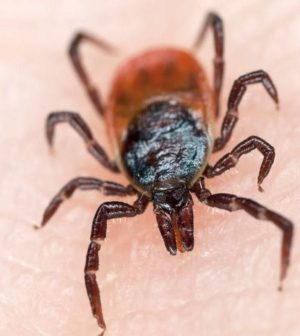- Skip Storing This Everyday Product in the Fridge Door
- Green Tea + B3 Pairing May Boost Brain Health
- Navigating Your Midlife Crisis: Embracing New Possibilities
- City Raccoons Showing Signs of Domestication
- Mapping the Exposome: Science Broadens Focus to Environmental Disease Triggers
- One Week Less on Social Media Linked to Better Mental Health
- Your Brain Changes in Stages as You Age, Study Finds
- Some Suicide Victims Show No Typical Warning Signs, Study Finds
- ByHeart Formula Faces Lawsuits After Babies Sickened With Botulism
- Switch to Vegan Diet Could Cut Your Greenhouse Gas Emissions in Half
Tick-Borne Illness Babesiosis Spreads to New U.S. States

Cases of a parasitic disease spread by ticks have been on the rise, particularly in states in the Northeast that had previously seen few cases, U.S. health officials reported Friday.
Between 2011 and 2019, more than 16,000 cases of babesiosis were reported in the United States, with the lion’s share of those cases reported in the Northeast, the latest data from the U.S. Centers for Disease Control and Prevention shows. Over that period, the highest number of cases were reported in New York, Massachusetts and Connecticut.
Meanwhile, Maine, New Hampshire and Vermont, where babesiosis had not been endemic, saw increases that were similar to or higher than those seen in states where the disease is endemic, the CDC researchers discovered.
“While the exact reasons for the geographic spread of ticks and the diseases they carry, including babesiosis, are unclear, a number of factors may contribute,” said lead researcher Megan Swanson, an epidemiologist in the CDC’s division of parasitic diseases and malaria.
“For example, the spread of Lyme disease over the past several decades has been linked to changes in land use patterns,” Swanson explained. “Suburban development in these areas has increased the spread of these germs because people, ticks, deer, and tick hosts such as mice and chipmunks, are in close contact.”
One expert offered another explanation.
“The disease is going north,” Edouard Vannier, a babesiosis expert at Tufts Medical Center in Boston, told The New York Times. “And it’s probably due to climate change.”
Babesiosis is spread by the same ticks that spread Lyme disease. It can cause fever, chills, sweats, fatigue, muscle and body aches, headache, loss of appetite and nausea. It can also cause gastrointestinal symptoms, including anorexia, nausea and dark urine.
“Babesiosis is different than Lyme, even though carried by the same deer tick, and it’s easy to miss,” said Dr. Marc Siegel, a clinical professor of medicine at NYU Langone Medical Center in New York City.
“Patients can be asymptomatic and the doctor has to be on the lookout for it, as common symptoms can be easy to mistake for something else,” said Siegel, who had no part in the study.
Most asymptomatic cases of babesiosis do not need treatment, the CDC said. Treatment decisions should be individualized, especially for patients who have or are at risk for severe or relapsing infection.
For symptomatic patients, babesiosis usually is treated for at least a week to 10 days with a combination of drugs, either the antimicrobial atovaquone plus the antibiotic azithromycin; or the antibiotic clindamycin plus quinine.
Given the rising number of babesiosis cases, Siegel often errs on the side of caution.
“I am on the lookout for it and generally test for it whenever I test for Lyme,” he noted.
According to the CDC, the way to prevent getting babesiosis is to follow the same steps that guard against infection with other tick-borne diseases.
The agency advises:
- Stay on cleared trails and minimize contact with leaf litter, brush and overgrown grasses, where ticks are likely to be found.
- Minimize the amount of exposed skin. Wear socks, long pants and a long-sleeved shirt. Tuck your pant legs into the socks. Wear light-colored clothing, to make it easier to see and remove ticks.
- Use tick repellents that contain DEET on your skin and clothing.
- After being outside, check your body for ticks and remove any that are found.
- Remove ticks from clothing and pets before going indoors.
- Remove ticks as soon as possible, by using pointed tweezers. Grab the tick’s mouth close to the skin, and slowly pull the tick straight out until the tick lets go.
The report was published March 17 in the CDC’s Morbidity and Mortality Weekly Report.
More information
For more on babesiosis, head to the U.S. Centers for Disease Control and Prevention.
SOURCES: Megan Swanson, epidemiologist, division of parasitic diseases and malaria, U.S. Centers for Disease Control and Prevention; Marc Siegel, MD, clinical professor, medicine, NYU Langone Medical Center, New York City; Morbidity and Mortality Weekly Report, March 17, 2023; The New York Times
Source: HealthDay
Copyright © 2025 HealthDay. All rights reserved.










